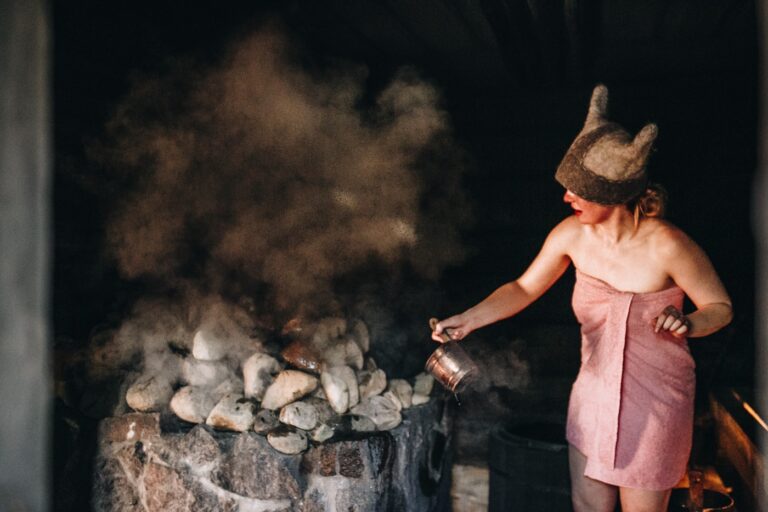Thwack! Thwack! I am lying naked on a wooden bench, while an Estonian woman beats me with birch leaves. To be clear, there is an innocent explanation. I am in rural Estonia, experiencing the mysteries of a traditional smoke sauna.
It all began a month ago when I got COVID. Where better to recharge the batteries than this cool, calm country in Europe’s north-eastern corner? A flat land, half-hidden by forests, Estonia has some of the cleanest air you can find. Fun fact: it also has more supermodels per capita than any other nation on the planet.
Disappointingly, arriving at the Mooska smoke sauna near the Latvian border, I am not greeted by Kaitlin Aas or Elisabeth Erm. Yet the experience is one I won’t forget.
Admittedly my inhibitions take a while to dissolve in the steam. Even after learning that nudity is encouraged, I cling to my skimpy towel as I enter the hut. At first, too, I arch an eyebrow as Eda Veeroja, the earthy priestess of the place, explains the ancient magic of the sauna (which she says as sa-oo-na): how it puts you in touch with the ghosts of your ancestors, and so on.
My cynicism doesn’t last. When Eda, now totally nude, bangs a drum and starts chanting, I and the other sweat-drenched members of my group join in. We are all sporting felt sauna hats that make us look like pixies. If it gets too hot, we take a dip in the natural pool outside. It’s cold, yet after the sweltering heat, a relief.
Sa-oo-nas are a big deal in Estonia. Many households have one. But a smoke sauna is a bit different. The scalding steam is laced with the fragrance of the smouldering wood. Then there’s the pagan stuff. At one point, we whisk ourselves with leaves while chanting, “May the wisdom of my bottom go to my brain.” Personally, I doubt if I have much wisdom in my bottom, but I go along with it. For an uptight Englishman, the feeling of shrugging off most — if not quite all — of one’s inhibitions is wonderfully refreshing.
Whatever next, I ask myself. The answer is the niche pastime of bog-shoeing. The bits of Estonia that aren’t forest are largely bog. It’s a unique habitat, with a russet beauty all its own.
The next morning, we strap on plastic shoe-extensions that resemble tennis racquets, and set off with bog experts Algis and Jana. They make sure we don’t get bogged down, while leading us over the soggy, spongey terrain. Algis spots a diminutive bog frog. Jana distinguishes the hardy sphagnum that gives the bog its reddish colour from the occasional sundew: a tiny carnivorous flower that can, she advises us, be used to treat herpes. Amazingly, the bog is scattered with wild cranberries. They taste cold and sweet.
From there, it’s a short drive to an excellent picnic. Then Jana and Algis produce two-man canoes and we explore the Raudna river. Estonia gets cold in the winter, but it is balmy as we nose along between walls of slender birch, warmed by the September sun and the lazy strokes of our paddles. Seeing the thick forests all around, we can easily imagine how, when the Soviets invaded Estonia in 1944, rebels took to the woods. Known as the Forest Brothers, some lived there until the 1970s without getting caught.
This year, former Soviet countries are celebrating the 30-year anniversary of the fall of Communism. In Estonia, it was achieved with the help of the Singing Revolution: a series of events at which, by gathering and singing patriotic songs, the Estonians sent a message to Moscow. Three decades later, emotions still run high. While telling us about those times, our otherwise unstoppable tour guide, Eva-Maria Egipt-Peenmaa, keeps breaking down in tears. She remembers her father driving her, aged six, to join “the Baltic Way”. In August 1989, 2 million people held hands, creating a human chain that crossed Estonia, Latvia and Lithuania.
Soviet occupation does not define Estonia’s history, Eva-Maria insists. The owner of her own tour company, she is an example of the can-do spirit that’s making her country a hub for start-ups. Outside a hipster bar in Tallinn, the country’s picturesque capital, I fall into conversation with a young Frenchwoman who, frustrated by Gallic red tape, has moved to Estonia to set up her own vegan cooking company. We are in the trendy Telliskivi part of town, which is packed with bars, galleries and highly grammable street art.
Just across the square stands a famous work by the Estonian Banksy, a mysterious street artist known as Edward von Longus. It shows a skeleton dancing with a man who is cheerfully taking a selfie. This is in playful reference to the best-known example of medieval Estonian art, the 16th century painting Danse Macabre by Bernt Notke. Now housed in Tallinn’s Niguliste Museum, this splendid work shows a line of skeletons forcing humans to dance. In von Longus’s version, the tables are turned. The Grim Reaper has become just another photo op.
This pairing of works shows how skilfully Estonia bridges past and present. The cobbled streets of Tallinn’s Old Town are delightful. But the country also has fantastic contemporary cuisine (not to mention lagers), from the potato pancake and smoked fish at Viljandi’s Fellin Cafe to the exquisite tasting menus at the Hedon Hotel in the beach resort of Parnu. You can surrender to the ancient magic of the smoke sauna, or enjoy the more modern, and far more conventional, Silent Spa treatment at the Hedon.
It would be an exaggeration to call my bout of COVID an encounter with the Grim Reaper. But by the time I head home after five days in Estonia, I have eaten well and been beaten well. I’ve swum, gone bog-shod, met lovely locals and learned a lot. So if I happen to bump into Death any time soon, I think I may just take a selfie.

